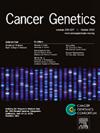Glioma grade and mortality in relation to sequence variation in the mitochondrial genome
IF 2.1
4区 医学
Q4 GENETICS & HEREDITY
引用次数: 0
Abstract
Purpose
Glioma arises from glial cells and comprises ∼80 % of malignant adult brain tumors. The polymorphic mitochondrial genome plays a key role in maintaining redox homeostasis and generation of reactive oxygen species (ROS). ROS have a well-established role in glial tumors. We investigated associations between germline mtDNA variants and haplogroups with glioma grade and glioblastoma (GBM) survival.
Methods
We conducted germline mtDNA sequencing for 388 patients (300 Caucasians, 88 African Americans [AA]) with incident glioma (105 non-GBM, 283 GBM). Across all patients we identified 1431 homoplasmic mtDNA variants, including 692 variants observed only in Caucasians, 474 only in AAs, and 265 in both groups. We estimated Odds Ratios (OR) and 95 % Confidence Intervals (CI) for mtDNA common variants, haplogroups, and gene variant burden in relation to glioma grade and tertiles of survival in GBM patients. Bonferroni and Benjamini-Hochberg correction were applied for multiple comparisons.
Results
No mtDNA haplogroup was associated with glioma grade or patient survival in GBM. Common variants m.3010G>A, m.195T>C, and m.16189T>C were linked to lower-grade glioma risk. For GBM survival, m.1719G>A, m.14766T>C, m.16129G>A, and m.204T>C were associated with a poorer prognosis while variant m.73A>G was associated with an improved prognosis. A higher variant burden in MT-ND1 and MT-ND5 was associated with a better prognosis. No results remained statistically significant after correction.
Conclusion
This is the first comprehensive study of germline mtDNA sequence variation in relation to glioma grade at diagnosis and gliobastoma patient survival. Results warrant further study in larger populations and investigation of biologic mechanisms linking mtDNA polymorphism to these endpoints.
胶质瘤分级和死亡率与线粒体基因组序列变异的关系
脑胶质瘤起源于神经胶质细胞,约占成人恶性脑肿瘤的80%。多态线粒体基因组在维持氧化还原稳态和活性氧(ROS)的产生中起着关键作用。活性氧在神经胶质肿瘤中有明确的作用。我们研究了种系mtDNA变异和单倍群与胶质瘤分级和胶质母细胞瘤(GBM)存活率之间的关系。方法对388例(白种人300例,非裔美国人88例[AA])脑胶质瘤患者(非GBM 105例,GBM 283例)进行种系mtDNA测序。在所有患者中,我们发现了1431个同质mtDNA变异,其中692个仅在白种人中观察到,474个仅在aa中观察到,265个在两组中都观察到。我们估计了mtDNA常见变异、单倍群和基因变异负担与胶质瘤级别和GBM患者生存分位数相关的比值比(OR)和95%置信区间(CI)。多重比较采用Bonferroni和Benjamini-Hochberg校正。结果mtDNA单倍群与胶质瘤分级或患者生存率无相关性。常见的m.3010G>A、m.195T>;C和m.16189T>;C与低度胶质瘤风险相关。对于GBM的生存,m.1719G>A、m.14766T>C、m.16129G>;A和m.204T>;C与预后较差相关,而m.73A>;G变体与预后改善相关。MT-ND1和MT-ND5较高的变异负担与较好的预后相关。校正后的结果没有统计学意义。结论本研究首次全面研究了种系mtDNA序列变异与胶质瘤分级诊断和胶质瘤患者生存之间的关系。结果需要在更大的人群中进行进一步的研究,并调查mtDNA多态性与这些终点的生物学机制。
本文章由计算机程序翻译,如有差异,请以英文原文为准。
求助全文
约1分钟内获得全文
求助全文
来源期刊

Cancer Genetics
ONCOLOGY-GENETICS & HEREDITY
CiteScore
3.20
自引率
5.30%
发文量
167
审稿时长
27 days
期刊介绍:
The aim of Cancer Genetics is to publish high quality scientific papers on the cellular, genetic and molecular aspects of cancer, including cancer predisposition and clinical diagnostic applications. Specific areas of interest include descriptions of new chromosomal, molecular or epigenetic alterations in benign and malignant diseases; novel laboratory approaches for identification and characterization of chromosomal rearrangements or genomic alterations in cancer cells; correlation of genetic changes with pathology and clinical presentation; and the molecular genetics of cancer predisposition. To reach a basic science and clinical multidisciplinary audience, we welcome original full-length articles, reviews, meeting summaries, brief reports, and letters to the editor.
 求助内容:
求助内容: 应助结果提醒方式:
应助结果提醒方式:


